
Copyright © 2012 LITUANUS Foundation, Inc.
Volume 58, No.2 - Summer 2012
Editor of this issue: Loreta Vaicekauskienė
 LITHUANIAN
QUARTERLY JOURNAL OF ARTS AND SCIENCES
|
ISSN
0024-5089
Copyright © 2012 LITUANUS Foundation, Inc. |
|
Volume 58, No.2 - Summer 2012 Editor of this issue: Loreta Vaicekauskienė |
Behind the White Curtain
The Lithuanian Pavilion
at the 54th Venice Biennale
DANAS LAPKUS
DANAS LAPKUS is the new art editor of Lituanus. He is an attorney and author in Chicago.
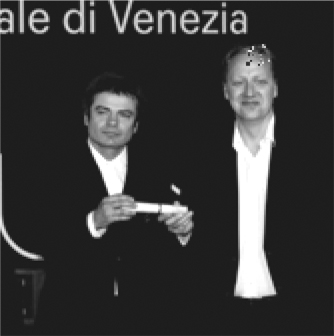 |
| Darius
Mikšys receiving the Special Mention Award from Kęstutis Kuizinas, Commissioner of the Lithuanian Paivlion |
The Lithuanian Pavilion at the 2011 Venice Biennale International Art Exhibition has won the Special Mention award. It’s a particular honor, since La Biennale, held in Venice, Italy every other year since 1895, is considered by many to be the most important and prestigious event of the art world. La Biennale is comprised of numerous national pavilions scattered around the Old Town of Venice. Each pavilion features an exhibit organized by a curator selected by its country. The national pavilions compete for the Lion Awards, which are awarded by international juries.
There were 76 national pavilions at La Biennale in 2011. The Golden Lion for the Best National Participation went to Germany (Christoph Schlingensief); Christian Marclay of the United States took the Golden Lion for the Best Artist; and the Silver Lion for a Promising Young Artist went to Haroon Mirza of Great Britain. The jury awarded two Special Mentions: to Klara Liden of Sweden and to the Lithuanian Pavilion’s exhibit,
Behind the White Curtain, Curator Darius Mikšys, Commissioner Kęstutis Kuizinas. “It’s an odd moment to come across a project that feels completely new and, at the same time, progressive and likeable,” wrote the art critic Karen Archey upon visiting Behind the White Curtain at the Lithuanian pavilion.
In his initial proposal for Behind the White Curtain, Darius Mikšys stated that he wanted to feature the works of artists who have received a State Grant from the Ministry of Culture of the Republic of Lithuania during the last two decades (1992- 2010). This collection would show Lithuanian art as a phenomenon resulting from the actions of the Lithuanian state and, by extension, Lithuanian society. The collection would allow an outside observer to comprehend the nature and the scale of the phenomenon and would enable its creator – Lithuanian society – to reflect upon itself.
Mikšys’s concept has arisen from the interplay of art, politics, and national identity. According to Mikšys, the Lithuanian state intentionally promotes a certain kind of art product by awarding state grants to certain artists. The state assumes the role of the art connoisseur and the curator. By its actions, the state creates an immense art exhibit that lasts for decades. How does one view such an exhibit, or is it even possible?
Mikšys got in touch with artists who have received a state grant from Lithuania’s Ministry of Culture over the past two decades, requesting work made during the time the artist received the award’s funding. Mikšys received 173 works, which were documented and made into a catalog. The works were then shipped to a Venetian church rented as the pavilion and archived behind a large white curtain, lending the exhibition its name. Visitors to the exhibition could browse the catalog and choose works to be retrieved from the archive and displayed in a structure custom-made for the exhibition.
An anonymous blogger described the Lithuanian pavilion as follows:
On entering, one is subjected to a rather sparse, gallery-like environment, with the majority of works stored behind the eponymous curtain. In front of the curtain, a temporary display of works is placed according to the whims of visitors to the space. Catalogues line the edges of the room, and once asked, staff will collect the works for the viewer and place them according to their specific wishes. The spectator then is empowered, resulting in both a very exciting, but also very unusual experience.
Archey spent some time observing visitors at the Lithuanian pavilion:
After
lingering for a while it became apparent that visitors interact
with the archive in various ways, some organizing their own
exhibition of various works, others (like me) finding an anomalous
work they’d like to see in real life. To be sure, much of the
art in the archive wasn’t exactly of
‘international’ caliber, offering
many an aesthetic cliché and non-ironic pastiche.
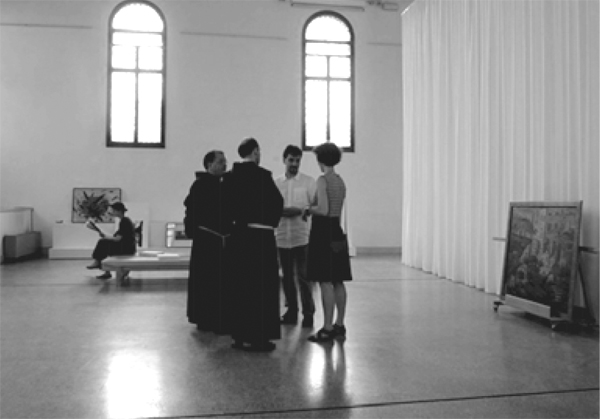
General exhibit space with specific art works displayed for temporary viewing
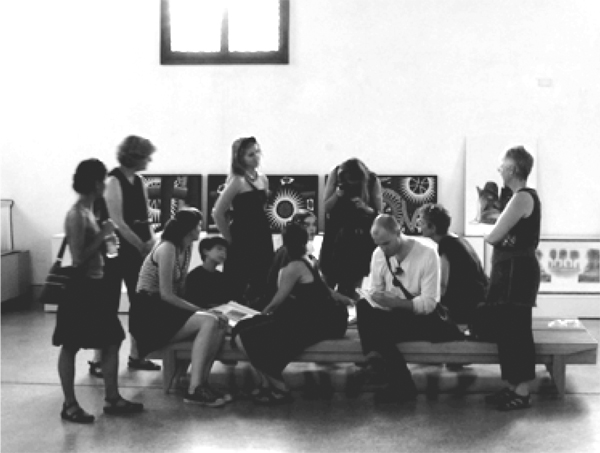
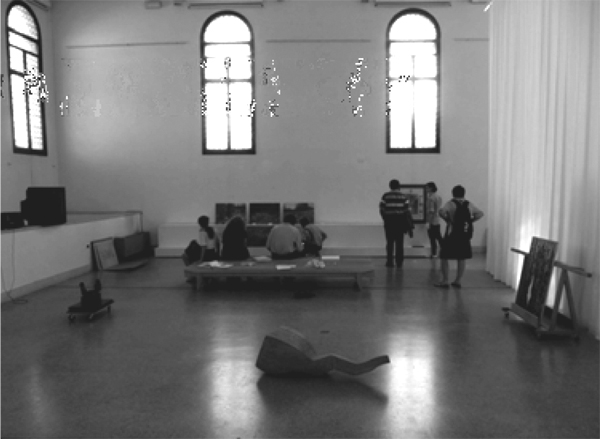
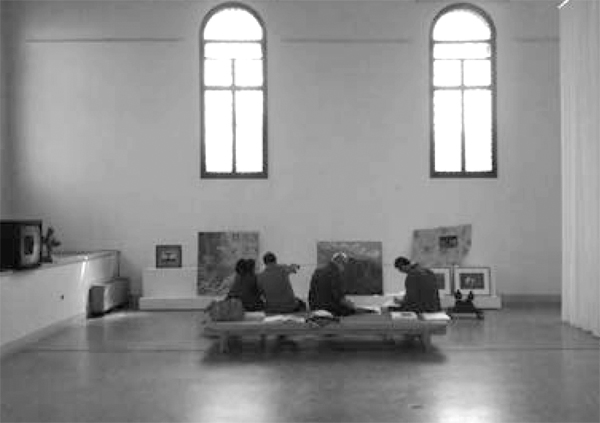
Visitors interact with the exhibit space
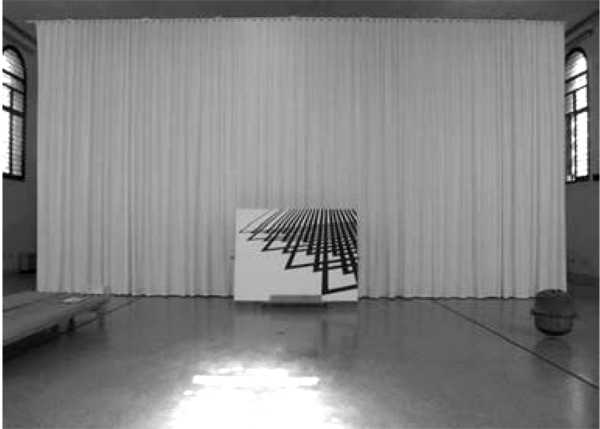
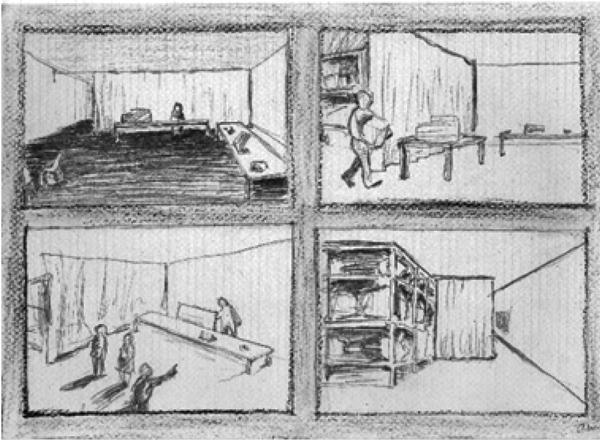
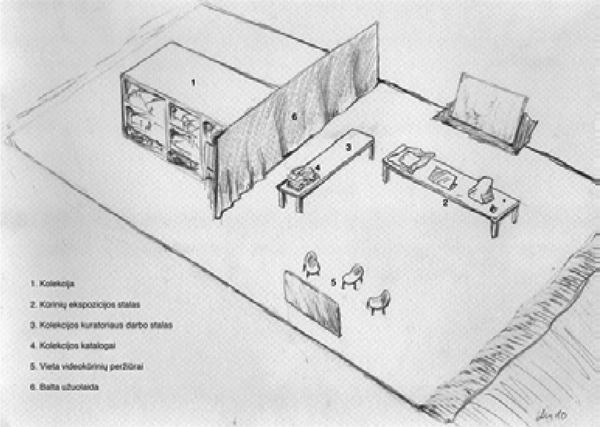
An excerpt from Darius Mikšys’s proposal for the pavilion
The pavilion functions as a gallery. It consists of two parts – the lobby/office space and the storage space. These are divided by a half-open white curtain, behind which one can see the packed collection of works. The visitor is greeted by the curator of the collection, who introduces the project’s concept and demonstrates the catalogue presenting the works of the State Grant recipients. The visitor chooses from the catalogue the work(s) that he or she would like to see. Then the chosen works are unpacked and brought to the visitor from the storage space. The visitor visually inspects them on the exhibition table standing in the lobby. These works remain on the table for other visitors to see until they are replaced by other works that the visitors express interest in. At this point, the works that were brought out first are packed again and taken back to the storage space behind the white curtain. In this way, each visitor can see a different, custom-made version of the Lithuanian collection. The presented works are registered.
This process of the works’ presentation is viewed as a performance. The performing person, or the curator of the exhibition, must be well acquainted with the collection’s content. He is the ‘ideal’ viewer who virtually ‘sees’ the collection as a whole.
Artists
in the collection
Valentinas Ajauskas, Gediminas Akstinas, Arvydas Ališanka, Alfonsas Vincentas Ambraziūnas, Aušra Andziulytė, Valentinas Antanavičius, Vėtrė Antanavičiūtė, Robertas Antinis, Žygimantas Augustinas, Ieva Babilaitė, Vytautas Balčytis, Arūnas Baltėnas, Arvydas Baltrūnas, Naglis Rytis Baltušnikas, Jurga Barilaitė, Ričardas Bartkevičius, Aušra Barzdukaitė-Vaitkūnienė, Darius Bastys, Rytas Jonas Belevičius, llja Bereznickas, Algimantas Biguzas, Jūratė Bogdanavičiūtė, Dovilė Budreikaitė-Dagienė, Eglė Budvytytė, Arturas Bumšteinas, Ieva Bunokaitė, Vitalijus Butyrinas, Linas Cicėnas, Romualdas Čarna, Ramūnas Čeponis, Gintaras Česonis, Saulius Čižikas, Ričardas Dailidė, Viktorija Daniliauskaitė, Joana Deltuvaitė, Rimantas Dichavičius, Laima Drazdauskaitė, Vytautas Dubauskas, Nerijus Erminas, Andrius Giedrimas, Tadas Gindrėnas, Danutė Gražienė, Bronius Gražys, Algis Griškevičius, Pranas Griušys, Giedrė Gučaitė, Leonardas Gutauskas, Vidmantas Ilčiukas, Romualdas Inčirauskas, Zita Inčirauskienė, Linas Julijonas Jankus, Darius Joneika, Agnė Jonkutė, Eduardas Juchnevičius, Violeta Juodzevičienė, Patricija Jurkšaitytė, Vidmantas Jusionis, Paulius Juška, Romas Juškelis, Vytautas Kalinauskas, Tomas Kapočius, Džiugas Katinas, Linas Katinas, Mindaugas Kavaliauskas, Jūratė Kirtiklytė, Elvyra Katalina Kriaučiūnaitė, Daumantas Kučas, Saulius Kuizinas, Arūnas Kulikauskas, Algimantas Kunčius, Algimantas Jonas Kuras, Andrius Kviliūnas, Kęstutis Lanauskas, Irma Leščinskaitė, Bernadeta Levulė, Rudolfas Levulis, Linas Liandzbergis, Dainius Liškevičius, Kęstutis Lupeikis, Aleksandras Macijauskas, Aurelija Maknytė, Vilmantas Marcinkevičius, Eimutis Markūnas, Raimondas Martinėnas, Dalia Mataitienė, Dalia Matulaitė, Dalia Mažeikytė, Evaldas Mikalauskis, Darius Mikšys, Vytautas Mockaitis, Jūratė Mykolaitytė, Vaclovas Nevčesauskas, Kristina Norvilaitė, Antanas Obcarskas, Aleksandras Ostašenkovas, Arvydas Pakalka, Lili Janina Paškauskaitė, Saulius Paukšys, Evaldas Pauza, Audronė Petrašiūnaitė, Gediminas Piekuras, Igoris Piekuras, Marijus Piekuras, Ramunė Pigagaitė, Grytė Pintukaitė-Valečkienė, Donatas Pirštelis, Romualdas Požerskis, Audrius Puipa, Jūratė Račinskaitė, Romualdas Rakauskas, Aistė Ramūnaitė, Marija Teresė Rožanskaitė, Egidijus Rudinskas, Bronius Rudys, Nomeda Saukienė, Algirdas Selenis & Aurika Selenienė, Algis Skačkauskas, Jolita Skėrytė, Simonas Skrabulis, Marius Skudžinskas, Rūta Spelskytė, Birutė Stančikaitė, Rasa Staniūnienė, Aloyzas Stasiulevičius, Jūratė Stauskaitė, Algirdas Steponavičius, Leonas Strioga, Antanas Sutkus, Nijolė Šaltenytė, Algimantas Šlapikas, Gerardas Šlektavičius, Rimantas Šulskis, Regina Šulskytė, Vytautas Švarlys, Algimantas Švažas, Rimtas Tarabilda, Solomonas Teitelbaumas, Vytautas Tomaševičius, Remigijus Treigys, Vytautas Umbrasas, Reda Uogintienė & Arūnas Uogintas, Eduardas Urbanavičius, Gintautas Vaičys, Henrikas Vaigauskas, Roberta Vaigeltaitė-Vasiliūnienė, Justinas Vaitiekūnas, Povilas Ričardas Vaitiekūnas, Arūnas Vaitkūnas, Nijolė Valadkevičiūtė, Arturas Valiauga, Kęstutis Vasiliūnas, Eglė Velaniškytė, Ramunė Vėliuvienė, Kazys Venclovas, Eglė Vertelkaitė, Rimaldas Vikšraitis, Vladas Vildžiūnas, Alfonsas Vilpišauskas, Nijolė Vilutienė, Mikalojus Vilutis, Juozas Vosylius, Aleksandras Vozbinas, Algimantas Vytėnas, Jūratis Zalensas, Elena Zavadskienė, Kazė Zimblytė, Gintaras Zinkevičius, Arvydas Žalpys, Birutė Žilytė, Darius Žiūra, Kazimieras Žoromskis, Irena Žviliuvienė, Stanislovas Žvirgždas
Photographs and some of the factual material in this article were used by permission of the Contemporary Art Center (CAC) of Vilnius, Lithuania. Kęstutis Kuizinas, Director of the CAC, is the Commissioner of the Lithuanian pavilion at the Venice Biennale International Art Exhibition.